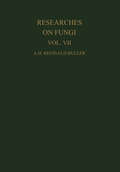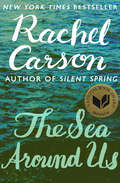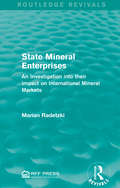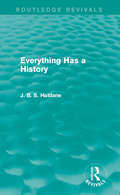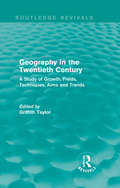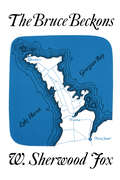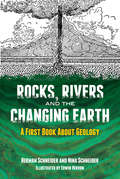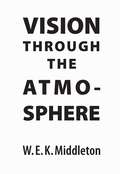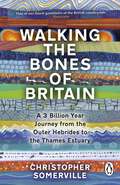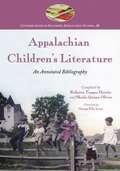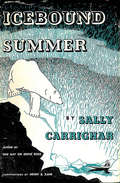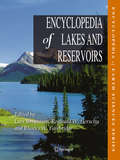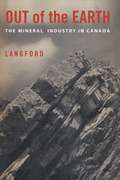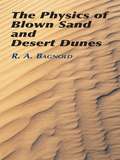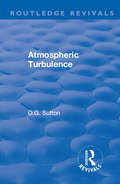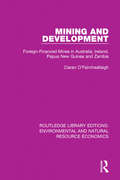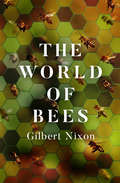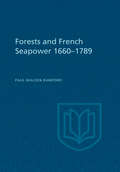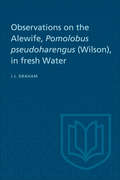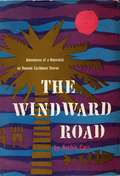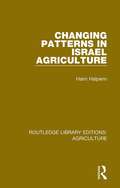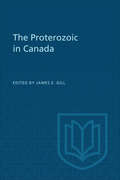- Table View
- List View
Researches on Fungi, Vol. VII: The Sexual Process in the Uredinales
by A. H. BullerThis is the last volume of the late Professor Buller's monumental work on Fungi. Before his death in 1943, Dr. Buller had completed the manuscript; the final preparation for press has been made by Dr. G.R. Bisby of the Imperial Mycological Institute, Kew. Publication of the volume has been sponsored by the Royal Society of Canada, and the work of proofreading undertaken by Dr. W.E. Hanna, Dr. J.H. Craigie, and Dr. F.L. Drayton; the index has been prepared under Dr. Hanna's supervision. A foreword has been contributed by Dr. Joseph A. Pearce, President of the Royal Society.
The Sea Around Us
by Rachel CarsonNational Book Award Winner and New York Times Bestseller: Explore earth&’s most precious, mysterious resource—the ocean—with the author of Silent Spring. With more than one million copies sold, Rachel Carson&’s The Sea Around Us became a cultural phenomenon when first published in 1951 and cemented Carson&’s status as the preeminent natural history writer of her time. Her inspiring, intimate writing plumbs the depths of an enigmatic world—a place of hidden lands, islands newly risen from the earth&’s crust, fish that pour through the water, and the unyielding, epic battle for survival. Firmly based in the scientific discoveries of the time, The Sea Around Us masterfully presents Carson&’s commitment to a healthy planet and a fully realized sense of wonder. This ebook features an illustrated biography of Rachel Carson including rare photos and never-before-seen documents from the Beinecke Rare Book and Manuscript Library at Yale University.
State Mineral Enterprises: An Investigation into their Impact on International Mineral Markets (Routledge Revivals)
by Marian RadetzkiState ownership in mineral industries has increased massively from the 1950’s affecting the world mineral sector greatly. Originally published in 1985, this study analyses the effects this had on the international market covering topics such as state takeovers of mineral firms, price stabilisation methods, state-owned enterprises in developing countries and whether state ownership will negatively impact private multinational companies. This title will be of interest to students of environmental studies.
Everything Has a History (Routledge Revivals)
by J. B. HaldaneIn this collection, first published in 1951, the central theme is that everything has a history, and that we cannot fully understand anything without some knowledge of its history. Professor Haldane writes mainly on geology, astronomy and zoology, but includes a variety of other topics, including eugenics, Einstein, and C. S. Lewis. His outlines of zoology, of the geology of England, and of the evidence for astronomical theories, will be of great use to students and teachers.
Geography in the Twentieth Century: A Study of Growth, Fields, Techniques, Aims and Trends (Routledge Revivals)
by Griffith TaylorThis title, first published in 1951, examines the growth, fields, techniques, aims and trends of geography at the time. The book is divided into three parts, of which the first deals with the evolution of geography and its philosophical basis. The second is concerned with studies of special environments and with advances in geomorphology, meteorology, climate, soils and regionalism. The last part describes field work, sociological and urban aspects, the function of the Geographical Society and geo-pacifics. Geography in the Twentieth Century will be of interest to students of both physical and human geography.
The Bruce Beckons
by W. Sherwood FoxFirst published in 1952, The Bruce Beckons was immediately acclaimed as a delightful guide to a uniquely beautiful and fascinating part of Ontario. Separating Georgian Bay from Lake Huron, the Bruce Peninsula's remarkable natural history and richly varied wildlife today continue to draw thousands of visitors every year. W. Sherwood Fox, a distinguished scholar who was for twenty years president of the University of Western Ontario, knew and loved the Bruce?s history and its folklore throughout his life. During his retirement he served several years as honorary president of the Federation of Ontario Naturalists.
Rocks, Rivers and the Changing Earth: A First Book About Geology
by Herman Schneider Edwin Herron Nina SchneiderYour bones and your teeth originated at the bottom of the sea, and the color of your blood came from deep underground. The water you drink, the clothes you wear, and the house you live in are all part of the Earth's history. With this well-illustrated book, you'll discover fascinating facts about geology, from how powerful prehistoric forces formed a river bend to the ways that tiny pebbles can reflect a million years of history.Your adventure begins with evidence that's all around you and can make even an ordinary walk in the park into an exciting revelation. Other subjects range further afield, from rivers of ice and volcanic activity to the formation of precious stones. In addition, a series of fascinating experiments provide you with insights into some of the geologic events that constantly transform our planet.
Vision Through the Atmosphere (Heritage)
by W.E.K. MiddletonIn recent years, the problem of seeing through the atmosphere has been given intensive and costly consideration in several quarters, but particularly in the Untied States and Great Britain. A problem which once concerned mainly the meteorologists has become of great importance in military tactics as well as in peacetime transportation. The present volume is the only full account in English of the physical, physiological, and psychological factors which lie at the basis of the calculation of the range of vision through the atmosphere. There is an extended chapter on instruments and one on the author's own theory of the colours of distant objects. The figures are from many sources althrough many of them have been drawn specially for this book. The bibliography contains 420 entries nearly all of which are directly referred to in the text.
Walking the Bones of Britain: A 3 Billion Year Journey from the Outer Hebrides to the Thames Estuary
by Christopher Somerville'[Somerville's] infectious enthusiasm and wry humour infuse his journey from the Isle of Lewis to southern England, revealing our rich geological history with vibrant local and natural history.' Observer'An illuminating take on the British landscape ... a remarkable achievement. ' - Tom Chesshyre'A meticulous exploration of the ground beneath our feet. Glorious.' Katherine Norbury'Somerville is a walker's writer.' Nicholas Crane'His writing is utterly enticing.' Country Walking''The physical book is sumptuous, with helpful supplementary materials including colour photographs, a timeline, maps and walking route resources.' Times Literary Supplement...........................................................................................................................................................................................................Travelling a thousand miles and across three billion years, Christopher Somerville (walking correspondent of The Times and author of Coast, The January Man and Ships of Heaven) sets out to interrogate the land beneath our feet, and how it has affected every aspect of human history from farming to house construction, the Industrial Revolution to the current climate crisis.In his thousand-mile journey, Somerville follows the story of Britain's unique geology, travelling from the three billion year old rocks of the Isle of Lewis, formed when the world was still molten, down the map south eastwards across bogs, over peaks and past quarry pits to the furthest corner of Essex where new land is being formed by nature and man.Demystifying the sometimes daunting technicalities of geology with humour and a characteristic lightness of touch, Somerville's book tells a story of humanity's reckless exploitation and a lemming-like surge towards self-annihilation but also shows seeds of hope as we learn how we might work with geology to avert a climate catastrophe.It cannot fail to change the way you see the world beyond your door.
Cotton Top
by Jean O'NeillSarah Jane (nicknamed Cotton Top) is a little Appalachian girl who is thankful for everything she has until a little girl from the city comes to visit. Then she learns new reasons to appreciate everything about her home.
Forest Regeneration in Ontario: Based on a Review of Surveys Conducted in the Province during the Period 1918-1951 (University of Toronto Forestry Bulletin #no. 2)
by R. C. HosieThis volume reports all the information presently available from the fifty-seven regeneration surveys carried out to the present by government and private agencies within the Province of Ontario. <P><P>It presents a general view of the nature of tree reproduction on cut-over forest land, followed by an analysis of the procedure in conducting and reporting regeneration surveys, and conclusions and recommendations for the conducting of future surveys.
Icebound Summer
by Sally CarrigharIn Icebound Summer, we are taken through a brief and intense arctic summer when seemingly frozen and lifeless tundra comes to life.
Encyclopedia of Lakes and Reservoirs
by Lars Bengtsson Rhodes W. Fairbridge Reginald W. HerschyLakes and reservoirs hold about 90% of the world's surface fresh water, but overuse, water withdrawal and pollution of these bodies puts some one billion people at risk. The Encyclopedia of Lakes and Reservoirs reviews the physical, chemical and ecological characteristics of lakes and reservoirs, and describes their uses and environmental state trends in different parts of the world. Superbly illustrated throughout, it includes some 200 entries in a range of topics, including acidification, artificialisation, canals, climate change effects, dams, dew ponds, drainage, eutrofication, evaporation, fisheries, hydro-electric power, nutrients, organic pollution, paleolimnology, reservoir capacities and depths, sedimentation, water resources and more.
Out of the Earth: The Mineral Industry in Canada
by G. B. Langford<p>OUT of the Canadian earth come treasures right and rare--gold, silver, uranium. Out of the earth come the raw materials of the industry--iron,copper, nickel, and the like. From deep in the earth flows the petroleum that keeps the wheels moving in our modern economy. Coal for our fires lies under the soil of Canadian prairies, mountains, and coastal seas. From the earth comes the building materials for towns and cities, roads, and bridges. From the earth come the glass and dishes for our homes, the salt for our tables, and the nylons we wear. Every Canadian uses the products of our mines. Many persons are employed in the mining industry, or in the multitude of industries dependent on its products. Many Canadians are investors in the industry, buying shares in mining companies, or processing industries, or the enterprises that sell mineral products to the public. <p>This book is the direct result of the desire expressed by Canadians in many walks ofl ife to know "more about mining." It takes the interested layman on a short trip through the complex mining industry. It describes, very clearly and readably, how the minerals were formed int he earth, how they are found, how they are taken out of the earth, and how the ores are processed and the petroleum transformed to high grade gasoline. It goes farther, telling how a mine is financed, how the prospector, the engineer, the government, the mine operator, financier, and investor combine to make the great Canadian mineral industry what it is. It tells, too, about the "jobs" in the industry--about the opportunities for geologists, geophysicists, engineers, production and physical metallurgists, and many other professions that young Canadians find both challenging and rewarding. This book gives the clue to the "language" of the mining industry--"conglomerate," "stope," "spudding in," "repressuring," "working option," "reorganization," "speculative risk"--to name only a few terms that are read on the financial page every day, and which the intelligent investory wants to understand clearly. <p>Out of the Earth tells about mining as it is today. We meet not just the propector carrying his pick, but the airborne magenetometer, which detects mineral deposits from the sky. Most readers have heard of the use of Geiger counters in locating radioactive substances, but here we read also, for example, about the seismic methods of mineral exploration, by which dynamite is fired in the earth and the shock-wave patterns calculated on instruments.Helping to make important points of the story clear are simple tables and 40 excellent line-drawings and charts. A group of photographs, chosen for informational value as well as pictorial interest, is included.</p>
The Physics of Blown Sand and Desert Dunes
by R. A. BagnoldAn expert treatise on the origin and evolution of dunes, this classic work was used by NASA in studying sand dunes on Mars and is appropriate for undergraduate and graduate students. The first book to deal exclusively with the behavior of blown sand and related land forms, its accessible style makes it an enduring reference more than half a century after its initial publication.The author studied the sands of North Africa for many years before World War II and is recognized as a leading authority on the subject. His three-part treatment begins with his wind-tunnel experiments, which he conducted to investigate the mechanism of sand transport. First, an account of the observed movement of the individual grains, followed by a chapter on the ground wind and its dependence on the type of surface over which it blows, form a comprehensive view of the interaction between wind and sand. Part Two considers small-scale surface phenomena, such as ripples and ridges, and the closely related subject of size-grading the grains.The third part uses the foregoing results to explain the growth and movement of dunes in general, and the peculiar characteristics of the two main dune types. A method of determining the internal structure of accumulated sand illuminates both the sand's carrying power for motor transport and its water-retention potential. A final chapter, derived from firsthand knowledge, examines the intriguing subject of "singing sand."
The Picture Book of Quantum Mechanics
by Hans Dieter Dahmen Siegmund BrandtThe aim of this book is to explain the basic concepts and phenomena of quantum mechanics by means of visualization. Computer-generated illustrations in color are used extensively throughout the text, helping to establish the relation between quantum mechanics--wave functions, interference, atomic structure, and so forth--and classical physics--point mechanics, statistical mechanics, and wave optics. Even more important, by studying the pictures in parallel with the text, readers develop an intuition for such notoriously abstract phenomena as the tunnel effect excitation and decay of metastable states wave-packet motion within a well systems of distinguishable and indistinguishable particles free wave packets and scattering in 3 dimensions angular-momentum decomposition stationary bound states in various 3-dimensional potentials hybrid states Kepler motion of wave packets in the Coulomb field spin and magnetic resonance Illustrations from experiments in a variety of fields, including chemistry, and molecular, atomic, nuclear, and particle physics, underline the basic as well as the practical importance of quantum mechanics. In the present, fourth edition all computer graphics are presented in full color. It also contains additional physics topics such as hybridization. Praise for Previous Editions "The book is highly recommended as a complement to any standard textbook in quantum mechanics, but it will also be valuable to all of us who studied quantum mechanics without the pictures." -- International Journal of Quantum Chemistry "This book would be an excellent basis for the study of special topics in a quantum physics course. Most serious students of physics and all of their teachers will want to consider having this orderly and graphic outline of introductory quantum theory at their fingertips." -- American Journal of Physics "Their aim is the presentation of the 'principal ideas of wave mechanics' in such a way that students can build a quantum intuition out of their graphics." -- Scientific American "This is a unique book. It does not provide a complete course in quantum theory, but as a companion work of reference it should be quite useful to students in providing insights into the dynamical structure of the theory." -- Nature
Atmospheric Turbulence (Routledge Revivals)
by O.G. SuttonOriginally published in 1955 Atmospheric Turbulence examines dynamic meteorology and the fundamental part it plays in the overall science of meteorology. The book examines the theory of atmospheric turbulence as a more mathematically developed area than largescale motions of the atmosphere and examines its significance in economic, military and industrial spheres. The book focuses on the effect and importance of atmospheric turbulence, not only to meteorologists, but the designers of large aircraft. The book addresses the effects of turbulence and the properties of the atmosphere that can be found closer to the ground. This book will be of interest to atmospheric physicists and meteorologists.
Can We Solve the Farm Problem: An Analysis of Federal Aid to Agriculture
by Murray R. BenedictCAN WE SOLVE THE FARM PROBLEM? An Analysis of Federal Aid to Agriculture
Mining and Development: Foreign-Financed Mines in Australia, Ireland, Papua New Guinea and Zambia (Routledge Library Editions: Environmental and Natural Resource Economics)
by Ciaran O'FaircheallaighThis book, first published in 1984, examines the economics and political issues raised by foreign investment in mineral development. It is an attempt to identify, as far as possible, what occurs in and between countries when foreign investments are made in mineral development, concentrating on two main themes: on the nature of the transactions which constitute the process of foreign investment on the physical level – money and instruments of credit, objects, information and people as they cross national boundaries – and on the nature of the relationships which are created between foreign investors and governments in the countries where the investments are made. The author argues that the nature of physical transactions plays a crucial role in determining the character of host country-foreign investor relations, and the policies and attitudes adopted by host country authorities exercise an important influence, in turn, on the physical effects of foreign investments. As such, the book constitutes a comprehensive overview of the economic and political factors involved in mining and its development.
The World of Bees
by Gilbert NixonAn entomologist presents a beautifully illustrated study of bees, from their behavior to social structures, colonies, and relationship to the environment. In this engaging and scholarly volume, entomologist Gilbert Nixon shares his lifelong fascination with bees. Nixon&’s childhood love of these curious insects led to decades of study as he learned to identify their distinctive markings and pursued the secrets of their mystifying behaviors.The World of Bees offers a comprehensive introduction to various species of bees, including honey bees, bumblebees, and leafcutter bees, as well as information on related insects such as botflies and wasps. With color illustrations by Arthur Smith, this expert volume covers all major topics in melittology, including mating habits, life cycles, pollination, bee dances, and more.
Forests and French Sea Power, 1660-1789
by Paul Walden BamfordBy choosing to concentrate upon discovering what forest resources were available to the French navy during the ancien régime and what use it was able to make of them, Mr. Bamford has not only provided the first monograph on that subject in the English language, but has gone far toward explaining why France was the loser in the long duel with England for the control of commerce and the extension of empire. <P><P> Two years of research in the Archives Nationales and in the Archives de la Marine in Paris, Toulon, and Rochefort enabled him to draw on contemporary sources of information of which little, if any, use has been made before, and a further year of research in the libraries of New York City, particularly in the rich Proudfit Naval Collection, also yielded new material. It is Mr. Bamford's achievement to have handled this vast store of primary sources with such skill and judgement that the reader, by turning over letters from disgruntled forest proprietors, reports from harassed maîtres on the trickery and recalcitrance of the peasants, instructions from the top echelon of the navy to inspectors in the forests, and a variety bills, receipts, and memoranda, is given at first hand an appreciation of the difficulties faced by the navy in trying to obtain timber and masts of the choice quality required for building ships-of-the-line. The navy had to compete with the merchant marine and with industrial and private users of fuel for supplies that were continually being depleted by mismanagement and by the conversion of forests to arable land. Measures, superficially admirable, for conserving the forests are found on closer examination to be at once over-precise and not properly enforced. Transport, even in a country so abundantly supplied with navigable rivers as France, was expensive and difficult.<P>Not only historians, but scholars in the field of forestry, economics, geography, agriculture, and transport will find this book illuminating.
Observations on the Alewife, Pomolobus Pseudoharengus (University of Toronto Biological Series #6)
by Joseph J. GrahamThe major study in this investigation was one of growth and form, carried out to evaluate differences in growth rates and body proportions between landlocked Lake Ontario and the anadromous Atlantic alewives. Particular attention was also given to the nature of the annual mortality that is characteristic of P. pseudoharengus in Lake Ontario.
The Windward Road: Adventures of a Naturalist on Remote Caribbean Shores
by Archie CarrThe Windward Road, published in 1956, made history. When Archie Carr began to rove the Caribbean to write about sea turtles, he saw that their numbers were dwindling. Out of this appeal to save them grew the first ventures in international sea turtle conservation and the establishment of the Caribbean Conservation Corporation.In addition to sea turtle biology, Carr recorded his general impressions, producing a natural history sprinkled with colorful stories.
Changing Patterns in Israel Agriculture (Routledge Library Editions: Agriculture #6)
by Haim HalperinFirst published in 1957. This study sought to analyse the problems raised by the changing forces and conditions in Israel in the middle of the twentieth-century. It discusses the impact of Israel’s achievement of political sovereignty upon its agricultural economy in the comparatively short space of six years. It examines the agricultural problems that arose as functions of the natural factors of production – land, water, climate, etc. It endeavoured to assess new and better possibilities of farming. This title will be of interest to students of geography and agriculture.
The Proterozoic in Canada (The Royal Society of Canada Special Publications #2)
by James E. GillProterozoic time produced much of great interest to geologists, and was of tremendous economic import to the people of Canada and the United States. Most of the iron deposits of the Lake Superior district, the Michigan copper deposits, the enormously important Sudbury nickel-copper-platinum deposits, the spectacular silver deposits of the Cobalt district, and all of the important uranium ores in the Shield area are considered to have formed during this period in geological time. Proterozoic rock groups include those Precambrian rocks which are least deformed and metamorphosed. Because of their important economic deposits, they have been examined in great detail in certain localities. The results of such examination, and of others which were for reconnaissance only, are summarized in this volume of the Royal Society of Canada. Suggestions are made for revision of previous interpretations of Precambrian history, and the terminology which grew out of them. Three papers deal with problems arising from the current use of the term Proterozoic, and with possible changes in its use to bring it more into accord with the facts. Contributors to this volume are: E.M. Abraham, Robert Bergeron, R.G. Blackadar, I.C. Brown, G.H. Charleswood, J.F. Davies, K.E. Eade, W.F. Fahrig, R.M. Farquhar, James E. Gill, H.C. Gunning, J.M. Harrison, D.F. Hewitt, W.W. Moorhouse, J.E. Reesor, S.M. Roscoe, R.D. Russell, James E. Thomson, Robert Thomson, L.J. Weeks, Alice E. Wilson, J.T. Wilson, G.M. Wright.
